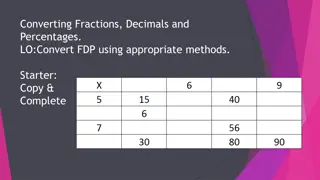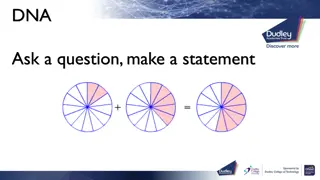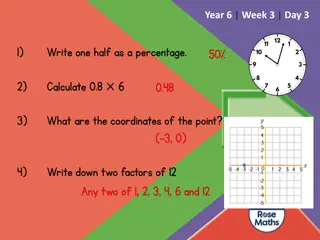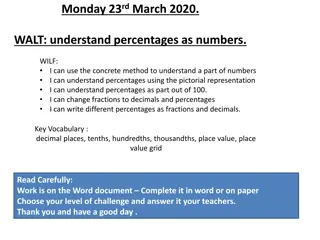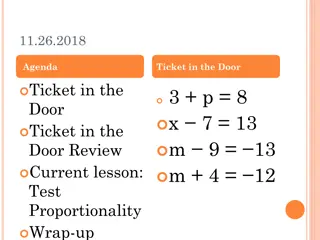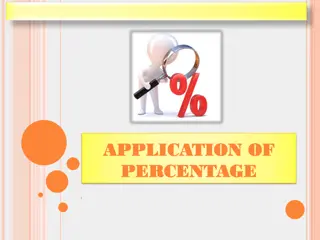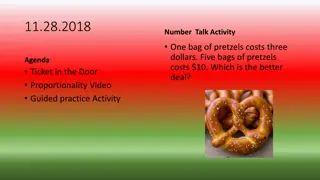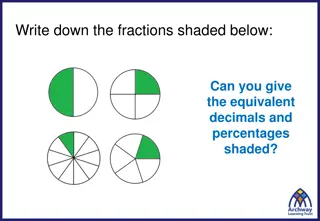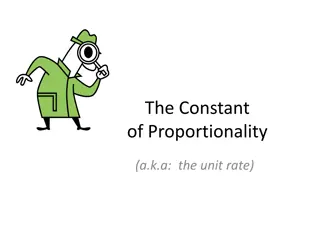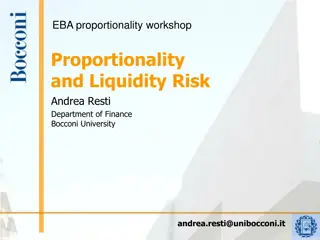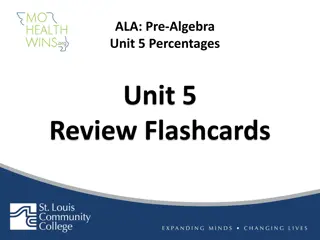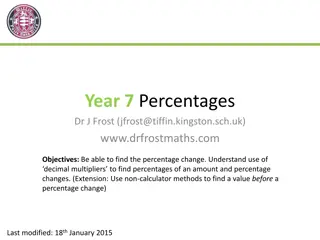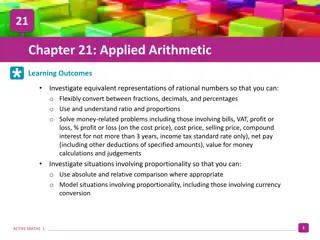Understanding Multiplicative Relationships in Percentages and Proportionality Activities
Engage with a comprehensive set of Checkpoints and additional activities focused on understanding multiplicative relationships, percentages, and proportionality in mathematics. Explore visual aids, problem-solving scenarios, and practical applications to enhance learning outcomes and skills advancement for Year 8 students. Published resources provide a structured approach to mastering key concepts and developing reasoning abilities.
Download Presentation

Please find below an Image/Link to download the presentation.
The content on the website is provided AS IS for your information and personal use only. It may not be sold, licensed, or shared on other websites without obtaining consent from the author. Download presentation by click this link. If you encounter any issues during the download, it is possible that the publisher has removed the file from their server.
E N D
Presentation Transcript
Checkpoints Year 8 diagnostic mathematics activities Understanding multiplicative relationships percentages and proportionality Twenty Checkpoints Ten additional activities Published in 2022/23
Checkpoints 110 Checkpoint Underpins Code 1: Shapes 2: Sponsored walk 3: Sponsored walk again 4: 110% 5: Percentage bars Percentages 3.1.5 6: Grids 7: 75% 8: Reasonable answers? 9: Attendance 10: In the sales *This three-digit code refers to the statement of knowledge, skills and understanding in the NCETM s Sample Key Stage 3 Curriculum Framework (see notes below for more information).
Checkpoints 1120 Checkpoint Underpins Code 11: Fill in the gaps 12: Who do you agree with? 13: Savings Percentages 3.1.5 14: Ten percentimetres 15: Relative values 16: Noah fence 17: Counters 3.1.2 3.1.6 18: Fallen arrows Proportionality 19: Empty boxes 20: On target *This three-digit code refers to the statement of knowledge, skills and understanding in the NCETM s Sample Key Stage 3 Curriculum Framework (see notes below for more information).
Percentages Checkpoints 1 15
Checkpoint 1: Shapes The images below show some parts of different shapes. What might each whole shape look? Draw or describe them. 25% 5% 70% 10% 25% 20% 60% 150% 120%
Checkpoint 1: Shapes (some possible solutions for the further thinking question)
Checkpoint 2: Sponsored walk Students in a school are doing a sponsored walk. Everyone walks the same distance at their own pace. After one hour, Mo is 24% of the way through the walk. He has walked 3600 m, so far. a) Nick is 48% of the way through the walk. How far has Nick walked, so far? b) Olga is 8% of the way through the walk. How far has Olga walked, so far? c) How long is the sponsored walk? Izzy walks twice as fast as Mo. How far has she walked when she s 24% of the way through the walk? How long has it taken her?
Checkpoint 3: Sponsored walk again Three students use their sponsored walk to raise money for charity. They record on double number lines what they have raised so far against their target. Mo Nick Olga a) What was each person s fundraising target? b) Write some sentences to compare their fundraising targets. Once the fundraising is complete, the three students raise a total of 3000 between them. Sketch a double number line to show this compared with their combined total target.
Checkpoint 3: Sponsored walk again (solutions) 0% 100% Mo 180 900 0 0% 100% Nick 0 180 450 0% 100% Olga 0 180 600 0% 100% 150% 1950 3000 0
Checkpoint 4: 110% Kathryn is an Olympic rower. Kathryn s coach tells her she needs to give 110% effort in her race. a) Is this possible? Why or why not? b) Is 110% possible or not possible in each of these situations? The cost of a house increasing by 110%. Scoring 110% on an exam. Paying 110% of a debt back. A baby being 110% of its birth weight. Being 110% older than when you started school. Eating 110% of a cake. Is it possible to decrease by 110% in any situation? Why or why not?
Checkpoint 5: Percentage bars Four friends live in different places. They draw percentage bars to show the percentage of days that they experienced different weather conditions. Work out how many days were sunny, cloudy, rainy or stormy for each person. a) b) A fifth friend wrote that it was sunny for two days and cloudy for eight, but forgot to write anything else down. Draw some possible bars. c) d)
Checkpoint 5: Percentage bars (possible solutions for further thinking question) A fifth friend wrote that it was sunny for two days and cloudy for eight, but forgot to write anything else down. Draw some possible bars. 20% 80% 10% 40% 50% 2% 8% 90% 15% 60% 25%
Checkpoint 6: Grids a) What percentage is shaded on the 100 grid on the right? b) Shade the same percentage on grids A to I. G A B C F D H E I Draw grids with different numbers of sections. How many are needed to shade the same percentage each time?
Checkpoint 6: Grids (some possible solutions) a) What percentage is shaded on the 100 grid on the right? b) Shade the same percentage on grids A to I. 30% G A B C F D H E I
Checkpoint 6: Grids (more possible solutions) a) What percentage is shaded on the 100 grid on the right? b) Shade the same percentage on grids A to I. 30% G A B C F D H E I
Checkpoint 7: 75% On the right are six students different strategies for finding 75% of 250. One of them is incorrect. a) Whose strategy is incorrect? b) Put the correct strategies in order of which you prefer to use. Caris Abdul Beth 250 10 = 25 25 7 = 175 25 2 = 12.5 175 + 12.5 = __ 250 100 = 2.5 2.5 75 = __ 250 2 = 125 125 2 = 62.5 125 + 62.5 = __ Darren Faaris Eden 250 4 = 62.5 250 62.5 = __ 250 75 = __ 250 4 = 62.5 62.5 3 = __ How could you adapt each method to find 90% of 250? Are there any that can t work for this percentage?
Checkpoint 8: Reasonable answers? Chris s answers to his maths homework will appear on the right. Without calculating, decide if they are reasonable answers or not. 10% of 350 is 3.5 1% of 3500 is 0.35 5% of 720 is 144 33% of 720 is 360 2% of 90 is 18 90% of 630 is 7 a) b) c) d) e) f) For the answers that you think were not reasonable, find the correct answers. What is the most efficient way to do this?
Checkpoint 9: Attendance Jasmine is ill and misses her first day of school. a) What is her percentage attendance after day one? Jasmine is better the next day and attends school. b) What is her percentage attendance after day two? Jasmine attends the rest of that week and all of the next week. c) What is her percentage attendance after day five? d) What is her percentage attendance after day ten? Jasmine says that she will need to attend every day for the rest of the year to get 100% attendance. e) Is Jasmine correct? Why or why not? There are 190 days in the academic year. What is the highest Jasmine s percentage attendance can be? What is the lowest?
Checkpoint 10: In the sales Orla has 20 to buy a present for her dad. There is a sale on at the shop. Below are some items with their original prices and the discounts to be applied. Which of the items can she afford? Shorts, 30 Jacket, 50 T-shirt, 25 Hat, 22 Scarf, 24 For those she can t afford, what discounts would she need so that she can afford any item in the shop?
Checkpoint 11: Fill in the gaps Use the values below to fill in the gaps. You can only use each value once there will be one left over. 5 __ % of __ is __. 500 50 2 __ % of __ is __. 250 20 250 __ % of __ is __. 250 1000 25 Use the leftover number to create some sentences in the same format. How can you use it in your first gap? What about the second? The third?
Checkpoint 12: Who do you agree with? Who do you think is correct? Why? Finding 20% of a number is easy. You just divide it by 20. Finding 10% of a number is easy. You just divide it by 10. Bryn Finding 50% of a number is easy. You just divide it by 50. Arne Cho What percentages would Bryn s calculation actually find? How about Cho s?
Checkpoint 13: Savings Kaylita and Patrick each save a different percentage of their earnings. Kaylita saves 5%. Patrick saves 10%. a) Who saves more? Kaylita is paid 4000 per month. Patrick is paid 1500 per month. b) Does this change your answer to part a? Patrick has a pay rise to 1800 per month. c) Does he save more than Kaylita now? Why or why not? Kaylita and Patrick now decide that they both want to save the same amount each month. What would need to change?
Checkpoint 14: Ten percentimetres? Three of the towers A to F have been made 10% taller. Three have been made 10 cm taller. Which is which? How do you know? E C B F A D A seventh tower is made 10% taller, and this also increases the height by 10 cm. How tall is the tower now? How about a tower that s made 5% taller and grows by 5 cm? Or 17% taller and grows by 17 cm? Can you explain these answers?
Checkpoint 15: Relative values Ron is eight years old. His sister Ellie is 25% older. a) How old is Ellie? b) When Ron is 16, how old will Ellie be? Jessica earns 8 per hour. Her company increases all earnings by 25%. c) How much does she now earn? d) Her aunt Adeola works for the same company and used to earn 16. What does Adeola earn after the pay increase? As Ron and Ellie get older, how does their percentage difference in age change? As Jessica and Adeola s earnings increase by the same percentage, how does the actual difference in their earnings change?
Proportionality Checkpoints 16 20
Checkpoint 16: Noah fence Noah has six hours to paint a fence a darker colour. He uses the graph on the right to show how much he should have painted after each hour. After two hours, the fence looks like this. a) Do you think Noah is on schedule to finish painting the fence in six hours? b) How should the fence look after four hours? c) How accurately do you think the graph is likely to represent Noah s progress? Noah s friend says he can paint 20% of the fence per hour. How would a graph of his rate on the same axes be different? How would it be the same?
Checkpoint 17: Counters I can see the fraction 3 5 Stevie I can see the ratio 2:3 Mick Four students look at these counters. They each say the first thing they see. Who do you agree with and why? Christine I can see the fraction 2 3 John I can see 40% I can see 150% Lindsey
Checkpoint 18: Fallen arrows Oh no the arrows of this function machine have fallen down the screen! They were all arranged carefully so that, when 10 was fed into the first one, the outcome of the last was 25. Can you find the right order for the arrows? 10 25 Could you create one red (multiplication) arrow that could be used to replace all of the arrows? Could you create one blue (division) arrow that could replace them all?
Checkpoint 19: Empty boxes Using a single digit in each box, how many different ways can you find to complete these statements correctly? You may use the same digit more than once. a) b) 3 is 6 of is of is of
Checkpoint 20: On target d Robyn is practising archery using the target on the right. The gaps between each circle are always the same. She hits the target five times. Arrow a lands 10 cm from the centre of the target. How far are arrows b to e from the centre of the target? e a 10 9 8 7 6 5 4 3 2 1 c b Robyn fires two more arrows. One is three times further from the centre than the other. Where could both arrows be?
Additional activities Activities A J
Activity A: Blank grids a) Shade part of the hundred grid on the right b) Complete the sentence: __% of the grid is shaded. c) Then shade the same percentage of shapes A to I. G A B C F D H E I Draw some more grids with different numbers of squares. Can you shade your percentage on each of these grids?
Activity B: Fewer grids a) What percentage is shaded on the 100 grid on the right? b) Shade the same percentage on grids A to F. E A B C F D Draw some more grids with different numbers of sections. Can you shade your percentage on each of these grids?
Activity B: Fewer grids (some possible solutions) a) What percentage is shaded on the 100 grid on the right? b) Shade the same percentage on grids A to F. 30% E A B C F D
Activity C: Value of a square If the whole hundred grid has a value of __, what is the value of: a) 1 square b) 2 squares c) 12 squares d) 50 squares e) 97 squares? f) How could you write your answers for parts a to e as calculations? If 12 squares are worth __, what would 1 square be worth? How about the whole grid?
Activity D: 42% Four students each shade the same percentage of their grids. a) What percentage is shaded? They stick the grids together. b) What percentage of the whole grid is shaded? What percentage of the total grid would be shaded if: The students shaded one more rectangle on each smaller grid? They then shaded four more rectangles on just the left-hand (blue) grid?
Activity E: Match up again a) Match into pairs using equivalent fractions, decimals or percentages. b) Write the missing fraction, decimal or percentage to make each pair a set of three. 1 5 1 4 0.3 30% 0.2 0.5 1 2 1.2 0.25 2 5 40% 120% Create another equivalent fraction to turn each set of three into a set of four. Can you think of an equivalent fraction that nobody else will choose?
Activity F: Relative ages Padma is eight years old. Her brother Howard is four and her sister Parvati is 16. Which of these statements are correct? Why? a) Padma says, My brother is 50% younger and my sister is 50% older than me. b) Howard says, One sister is 100% older and the other is 400% older than me. c) Parvati says, My brother is 25% younger and my sister is 50% younger than me. Maya says, My sister is 25% younger than me and my brother is 20% older than me. What could their possible ages be? How would Maya s sentence change in 20 years time?
Activity G: Just three gaps Use the values below to fill in the gaps. How many different statements can you make? You can use each value more than once. __ % of __ is __. 2 1000 25 250 200 20 50 500 5 Which values could you not write in the last gap? What numbers would you need to include so that you could write those values in the last gap?
Activity H: Graph A class of students took a test. The grades available were A, B, C or D. The graph helps the teacher convert a score out of 65 to a grade. Hugo scored 35 marks on his assessment. a) What grade did Hugo get? b) Estimate his percentage score. c) Estimate the minimum mark you need to get a grade. What calculation could you carry out to be more accurate? Marks (out of 65) A different test was scored out of 150 marks instead of 65. How will the graph for this test look different? How will it look the same?
Activity I: Matching machines Which of these function machines show the same calculation? 5 2 A E 10 4 10 2 B F 4 10 100 10 C 100 G 40 100 20 D H 5 2 Is there another function machine that would match any of these calculations? Is there one with a single red (multiplication) arrow? How about a single blue (division) arrow?
Activity J: Correct machines? Fawwaz says that all these machines could be replaced by the single calculation 0.8. Is he correct? Explain your reasoning. 80 10 10 A D 10 8 B E 8 10 15 12 C F 20 5 4 2 2 Where Fawwaz was not correct, what is the single calculation that could replace that machine? What other machines would have the same outcome?
25% 60% 70% 25% 20%
5% 10% 150% 120%
__% of the grid is shaded. Shade the same percentage of shapes A to I. G A B C F D H E I
__% of the grid is shaded. Shade the same percentage of shapes A to F. E A B C F D




